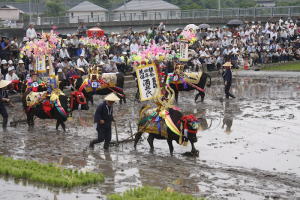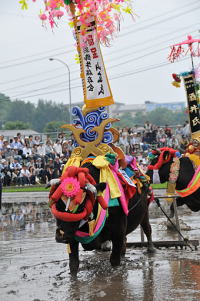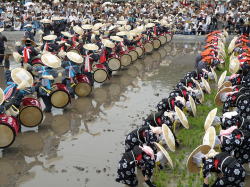|
Mibu no Hana Taue, the ritual of transplanting rice in Mibu, Hiroshima was registered by
UNESCO for Intangible Cultural Heritage Status in November, 2011.

"Mibu no Hana Taue’ is a Japanese agricultural ritual carried out
by the Mibu community in Kitahiroshima Town, Hiroshima Prefecture, to assure
an abundant rice harvest by honouring the rice deity. It is carried out
on the first Sunday of June every year after actual rice transplantations
in the community are completed.

On the day of the ritual, villagers bring more than ten cattle to Mibu
shrine to be adorned with elaborately decorated saddles called Hanagura,
and colourful necklaces. Hanagura are sculptured in the shape of helmets
and decorated gorgeously with gold-leaf or lacquer.The saddle weighs 20 to 30 kg, including its flags
and artificial flowers.
It is believed that Hana Taue originated either as a religious performance
to ask for a rich harvest, or as entertainment to ease the pains of hardworking
farmers, dating from at least the Edo period, and possibly much earlier.
 Cattle’s hooves churn and loosen the earth in preparation for laying seedlings.
This operation is called shirokaki. After the cattle have ploughed the
field, colorfully dressed girls called Saotome place seedlings inside cases
called naebune while singing a song conducted by an older man, known as
a Sambai. Sambai, named after the deity of rice fields, are in charge of
the smooth execution of the entire ritual and are familiar with the songs
and music associated with rice planting. Then, a man known as an Eburitsuki
begins to level the rice field with a tool, called an Eburi. It is said
that the deity of rice fields rests on Eburi. Cattle’s hooves churn and loosen the earth in preparation for laying seedlings.
This operation is called shirokaki. After the cattle have ploughed the
field, colorfully dressed girls called Saotome place seedlings inside cases
called naebune while singing a song conducted by an older man, known as
a Sambai. Sambai, named after the deity of rice fields, are in charge of
the smooth execution of the entire ritual and are familiar with the songs
and music associated with rice planting. Then, a man known as an Eburitsuki
begins to level the rice field with a tool, called an Eburi. It is said
that the deity of rice fields rests on Eburi.
Transplantation begins in the presence of the deity. Saotome faced by
Sambai transplant the seedlings one by one, walking backwards in line.
While the Sambai sings a leading song, locally considered as a parent song, holding a Sasara,
lengthwise-cut bamboo stick. Saotome sing another song, locally considered
as a child’s song. The Eburitsuki and the person who carries the seedlings
in Naebune follow the Saotome, and level the rice field as the seedlings
are planted. A musical band follows them, and plays the drums, flutes and
small gongs accompanying the songs of Sambai and Saotome. Once this ritual
transplantation is completed, the eburi is placed upside down in water
with three bunches of rice seedlings. Some say that the deity of rice fields
resides in this eburi, while others say the deity launches from it and
goes back to the heavens.
In Chiyoda, it is said that it never rains on the day of Hana Taue; it
is believed that it will be sunny even if it rained heavily the day before.
|



